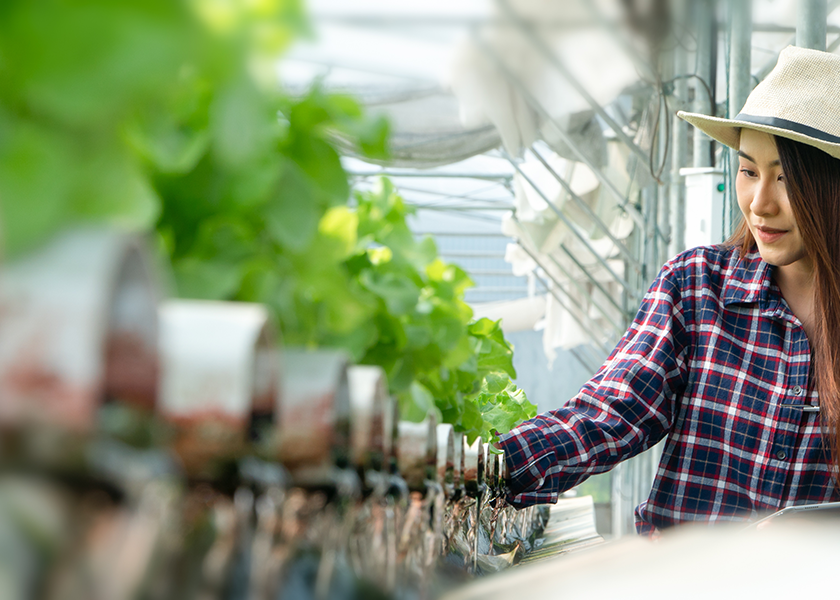How CEA is shining bright in the Lone Star State

Controlled environment agriculture continues to grow in Texas. And while many growers see the state’s strategic location for distribution as an advantage to setting up shop, it’s more than just location, says Tom Thompson, chief revenue officer for Austin-based Revol Greens.
“Texas is a land of abundance, not only defined by its landscapes but also in its rich spirit of independence — where even the gas stations (Hello, Buc-ee’s.) are a testament to its vastness,” Thompson says. “This unique blend of entrepreneurial spirit, coupled with a growing tech scene, creates an ideal environment for companies like Revol Greens. It’s this spirit, along with access to skilled labor and supportive communities, that led us to establish our fourth facility in Temple and locate our headquarters in Austin.”
Cesar Rodriguez, CEO of Sanger, Texas-based Texas Green Star, says many CEA growers in the state also tap into the rising interest in locally grown produce.
“People want to know where their products are coming from,” he says. “In addition to that, you have a high population and with a good income. We are just 35 minutes away from [Dallas Fort Worth International Airport]. We have around 60 million people in a 500-mile radius.
Thompson says the CEA industry in the last few years has seen significant growth and while there have been highs and lows, the industry continues on an upward trajectory.
“What initially began with a focus on tomatoes has since evolved both geographically and categorically, thanks to advancements in technology and genetics,” he says. “Over the past several years, we’ve also observed various CEA formats emerge and fade away. … Fundamentally, greenhouse growing remains a competitive and efficient method of cultivation that will continue to advance as a resilient alternative to underlying challenges across our food supply.”
Challenges ahead
Thompson says the CEA industry in Texas is at a crossroads. While the state provides ample opportunities, this abundance could create labor-sourcing challenges for CEA growers.
“There will be a continuous journey ahead to enhance operational efficiency and tackle resource constraints, particularly in water and labor,” he says. “In a state not typically known for abundant precipitation, we take pride in our ability to manage our environment in Texas. As we approach its first full year, we’ve achieved self-sufficiency by capturing all the water required for production through our collection systems.”
Rodriguez says CEA growers also struggle with summer heat and colder temperatures in the winter, even in greenhouses. Basil, for example, is susceptible to colder temperatures, he says. Texas Green Star faced a minor setback in February 2021 during the Great Texas Freeze, when a deep freeze hit the state about eight weeks before that year’s first harvest.
Another challenge, he says, is for growers new to the CEA space. While some companies open a new greenhouse in the state and bring brand recognition, some — like Texas Green Star — will face challenges with entering the market.
“Even though you have a high demand, when you are new in the market, that’s a challenge,” he says. “When you’re going to sit down in front of a big retailer or a big foodservice company, they will ask you, ‘Who are you selling to?’ You have to prove that you know what you’re doing, that you that you’re complying with all of your value propositions — quality, year-round production, local and a wide product portfolio. You can tell people, but until you prove it, they will not replace their existing supplier for a new one. .. You’re being perceived as a startup, even though we don’t look like a startup.”
Incredible growth
Thompson says despite the challenges CEA growers may face in the state, he still sees continued growth and diversification for the industry in the next five years.
“We are excited by the continued innovation we see across the sector across vine crops and berries, and are hopeful that advancements in technology, increased investment in research and development, and a growing emphasis on sustainability and food security will continue to bring this trend Texas’ way,” he says.
And this development, he says, will also benefit the consumer.
“The growth across the sector as categories expand with better products will continue to grow consumer awareness to the benefits and ultimately demand,” he says.
Rodriguez says Texas Green Star will continue to ramp up production and expects to hit 100% production by 2025.
He says there’s talk among CEA growers in Texas about forming an organization or association to better market the state’s produce grown in controlled environments. Rodriguez says the Texas industry wants to promote a unified presence both locally and federally to promote the state’s CEA.
While this is in its early stages, Rodriguez says he expects CEA growers will have a plan formulated later this year.
“We believe that it’s very important that we all cooperate to make the industry better in our state,” he says.







